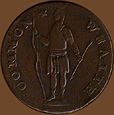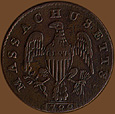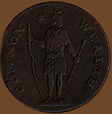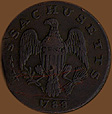Massachusetts Coppers 1787-1788
CENTS - continued
obverse |
|
reverse |
| |||
1788 Ryder 11-F MA cent - Perkins
Obverse: COMMON [star] WEALTH
Reverse: MASSACHUSETTS . 1788
Weight: 156.0 g (10.11 grams) Diameter: 28.7 mm Reverse die alignment: 180°
Comments: Produced from a die by Jacob Perkins. The obverse is distinguished as die 11 by the die break connecting the upper and lower serifs at the end of the letter E. Also the letters MM are close together while the AL are spaced apart. Note the letter L was actually made from an I punch with a small cut added to the die to turn the bottom right serif into a very short bottom horizontal stroke for an L.
The reverse can be distinguished as die F by the olive branch. Note the top leaf is just touching the second feather; also the two leaves on the left point toward the two uprights in the letter M. Also note in the bundle of arrows, the arrow furthest to the right points to the tip of the wing. This die shows the distinctive S with long serifs at either end, attributed to Perkins, giving it the appearance of being "closed" when compared with the less pronounced serifs on the "open" S in the dies attributed to Callender.
Provenance: Acquired through the the Robert H. Gore, Jr. Numismatic Endowment from the EANA auction of January 18, 1997, lot 566.
obverse |
|
reverse |
| |||
1788 Ryder 13-N MA cent without stop - Callender
Obverse: COMMON [star] WEALTH
Reverse: MASSACHUSETTS 1788
Weight: 150.2 g (9.73 grams) Diameter: 28.6 mm Reverse die alignment: 190°
Comments: Produced from a die by Joseph Callender. This is the variety without a stop after Massachusetts which is not listed in Crosby (Crosby listed only the rarer variety 6-N and not the more common 13-N). On the obverse note that the bottom point of the bow does not touch the ground. Also, the letters C and O are wider apart that the other letters.
The reverse is easily distinguished by the lack of a stop after the legend. Further, note the small die break appearing as a dot at the back of the eagle's head about level with his eye. The specimen shown is a somewhat dark example on a poor planchet. Note the planchet edge was clipped (obverse at 7-9 o'clock) before striking leaving fissure cracks on each side (at the first O on the obverse and the second S on the reverse). When the planchet was struck, the lettering was weak on both sides in this problem area. The planchet also has striations that appear as red streaks (across the Indian's chest on the obverse and at the eagle's legs, tail and date on the reverse), probably do to rolling when the planchet was made. Also note there are voids in the planchet at the Indian's stomach and on the lower section of the eagle's shield. I suspect all of these problems were present on the blank planchet before it was struck.
Provenance: From the Robert H. Gore, Jr. Numismatic Collection.
| Massachusetts Coppers p. 2 | Section Contents | Fugio Cents: p. 1 |
|
For viewing tips and information on optimal computer settings click
here.
For questions or comments contact Special Collections by: |



